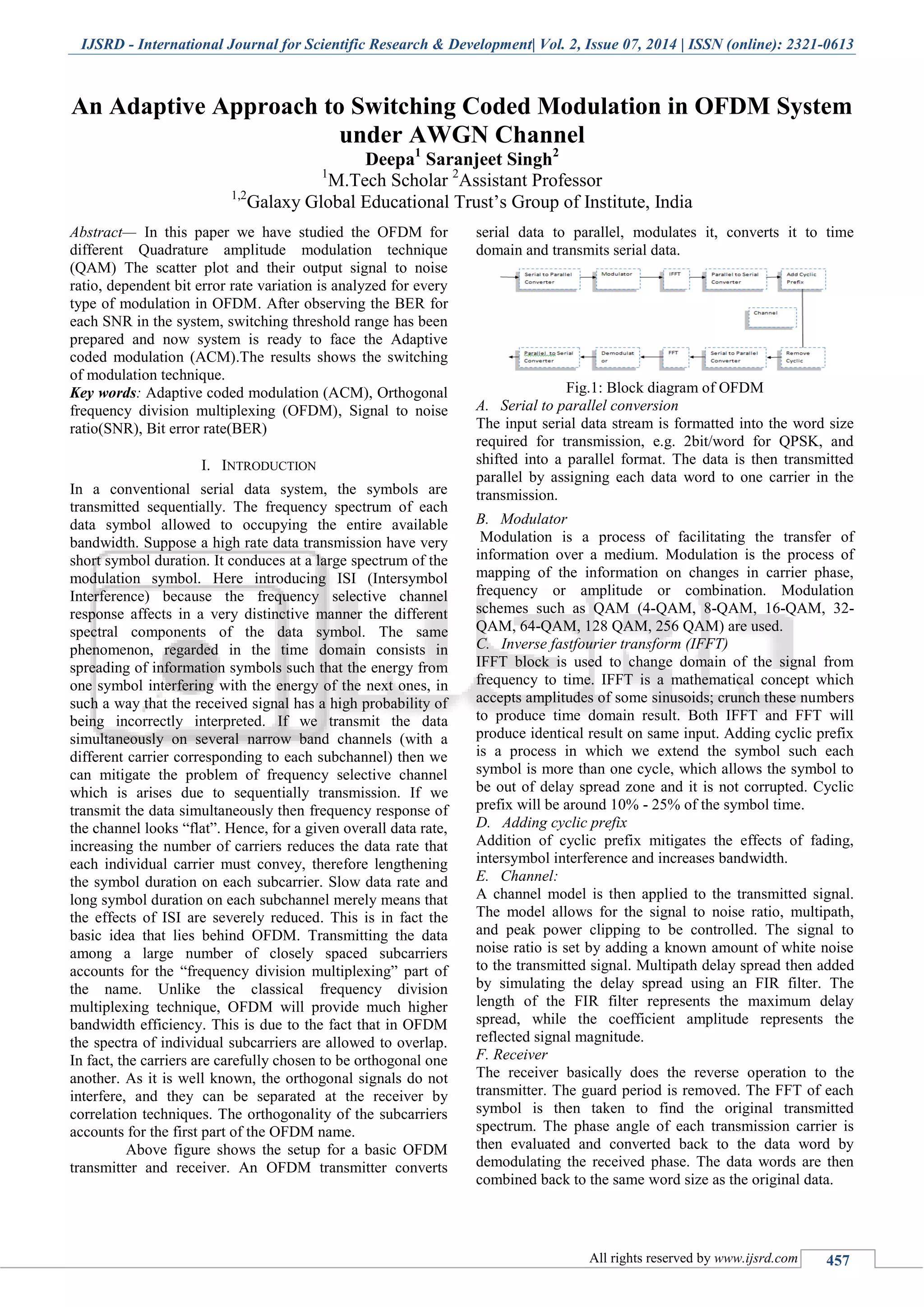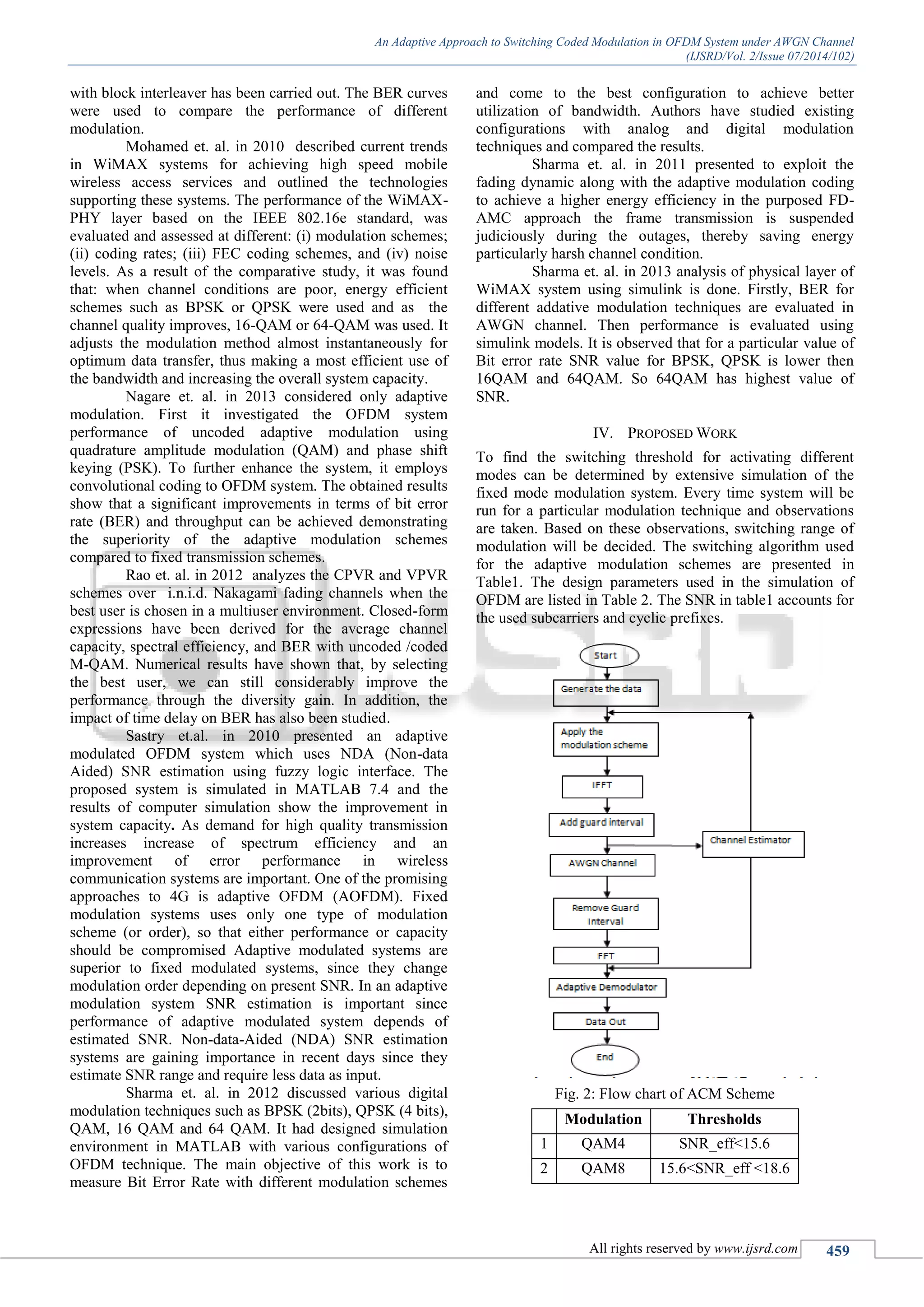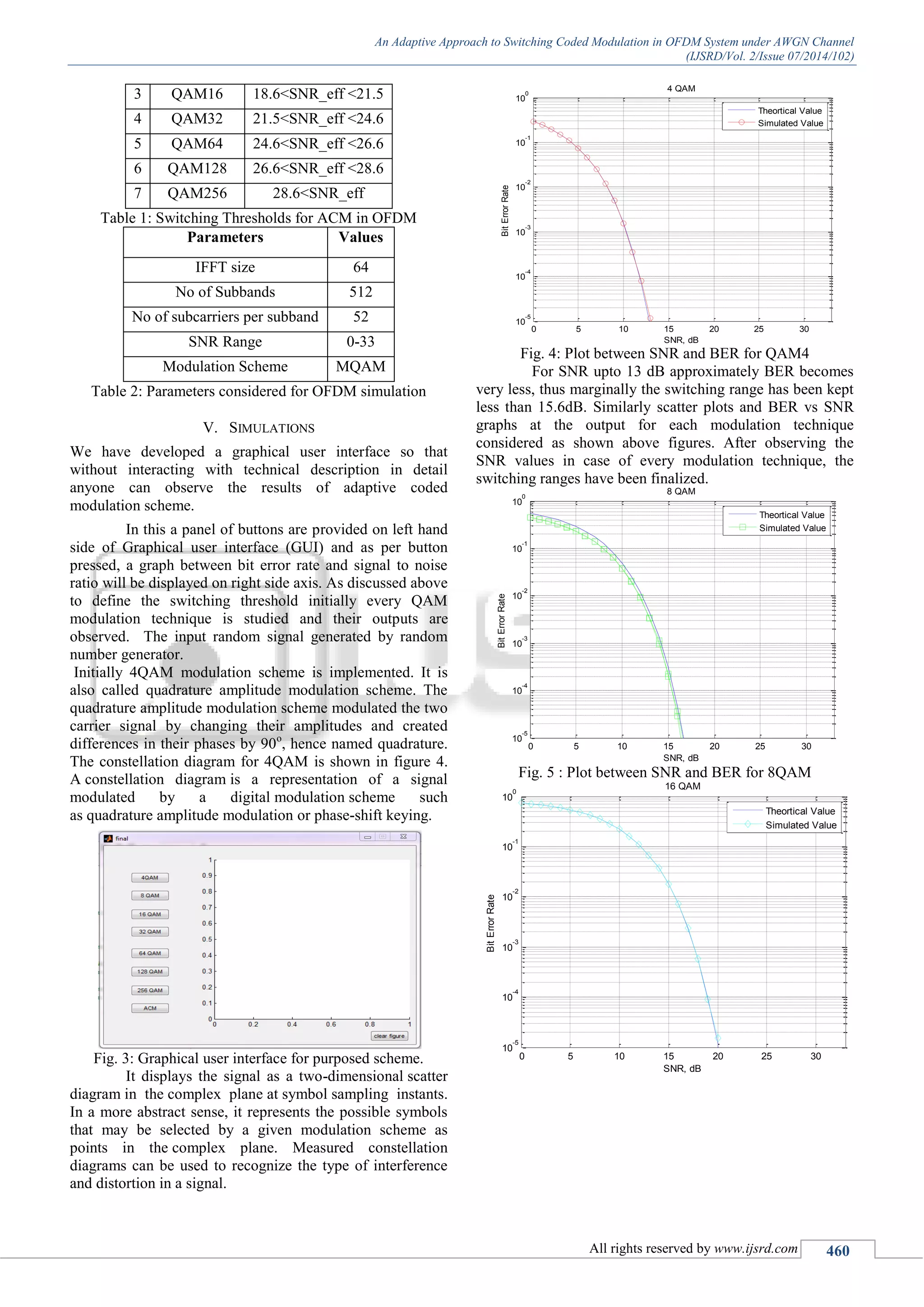This document discusses an adaptive approach to switching coded modulation in an OFDM system under AWGN conditions, focusing on the analysis of various QAM modulation techniques. It details the processes of system modeling, signal processing, and performance evaluation through simulations, aiming to find an optimal trade-off between bit error rate and spectral efficiency. The findings contribute to improving adaptive coded modulation strategies and highlight the importance of switching thresholds for effective data transmission.

![An Adaptive Approach to Switching Coded Modulation in OFDM System under AWGN Channel
(IJSRD/Vol. 2/Issue 07/2014/102)
All rights reserved by www.ijsrd.com 458
F. Removing cyclic prefix
Cyclic prefix added in the transmitter is removed to get
perfect periodic signal.
H. Fast Fourier Transform: FFT block performs reverse
operation to IFFT block. It is used to change domain of the
signal from time to frequency. A demodulator performs
reverse process of modulator which returns information.
Faezah et. al. in 2009 first investigated the OFDM
system performance of uncoded adaptive modulation using
quadrature amplitude modulation (QAM) and phase shift
keying (PSK), then to further enhance the system,
convolutional coding to OFDM system is employed . The
obtained results show that a significant improvements in
terms of bit error rate (BER).
Islam et. al. in 2009 analysis of an Wimax
(Worldwide Interoperability for Microwave Access) system
adopting concatenated Reed-Solomon and Convolutional
encoding with block interleaver has been carried out. The
BER curves were used to compare the performance of
different modulation.
II. SYSTEM MODEL
The OFDM system always suffers with the problem of
increase in bit error rate and decrease in spectral efficiency.
Various modulation techniques are available for OFDM
communication like 4QAM, 8QAM and higher modulation
techniques. Lower modulation techniques like 4QAM and
8QAM reduces the bit error rate but decreases the spectral
efficiency. So a technique is required which provides better
tradeoff between them. So, adaptive coded modulation is the
answer to this problem. We have designed the adaptive
coded modulation system for OFDM in MATLAB. To
design the adaptive coded modulation system. First of all we
have decided some OFDM specification like FFT size,
number of data subscribers, number of bits per OFDM
symbols, number of OFDM symbols. After these
specifications we have find out effective signal to noise
ratio. To find out effective signal to noise ratio, following
algorithm has been proposed in which signal to noise ratio
and cyclic prefix is also included.
Effective SNR = SNR dB +10log10(number
of data subscriber/FFT size) + 10log10(FFT
size / FFT size+ cyclic perfix )
(1.1)
After finding the effective signal to noise ratio we
have to find out Normalizing factor
k = (1/((2/3) (M-1))) (1.2)
Where
k= Normalizing factor. M=Modulation technique.
After calculating the Normalizing factor we
provide the data at the transmitter in complex form. After
that step grouping into multiple symbol and taking FFT .The
term (FFT size / (number of Data subscriber)) is for
normalizing the power of transmit symbol to 1.We also add
noise in the term( FFT size / FFT size+ cyclic prefix) is to
account for the wasted of energy due to cyclic prefix.
Noise =
1/ (2) [(number of OFDM symbol 80)
+j(number of OFDM Symbol 80)]
(1.3)
After adding the noise, format the received vector
and removing the cyclic prefix. After removing the cyclic
prefix convert it into frequency domain. When we get the
output at the receiver then we counting the error.
The received signal at any subcarrier can be
expressed as :
(1.5)
Where is the channel coefficient at any subcarrier, is
Simulated value of SNR = Error/(number of OFDM
symbol×number of bits per OFDM symbol) (1.4)
the transmitted symbol and is the Gaussian
noise sample. So the instantaneous BER can be calculated
using
BER =
Total Error/Total number
of bits transmitted
(1.6)
III. LITERATURE SURVEY
Albertazzi et.al. in 2004 proposed Fuzzy Rule Based System
assisted Adaptive Coding and Modulation scheme and
analyzed in contrast to other adaptive techniques as well as
fixed techniques. It is shown that FRBS is more powerful in
terms of throughput and bit error rate especially when bit
error rates are10-2
, 10-3
,10-4
.
Birla et.al. in 2012 presented capacity enhancement
of WiMAX system using adaptive modulation and code rate
in MATLAB. This paper focusing on the physical layer
design that is modulation (BPSK, QPSK, 8QAM, 16QAM,
32QAM,64QAM are used in this work) and convolution
codes(CC) with ½, ⅔ codes. Here various used modulation
types will be implemented in a single MATLAB function
that can be called with the appropriate coefficient
Bello et. al. in 2013 analyzed that for a constant
value of SNR, if we are decreasing the signal power then it
implies that noise is also decreasing & therefore bit loss &
packet losses are also reduced. These losses are almost zero
for a very low value of signal power such as 0.4 watt &
SNR greater than 15dB, but transmission will not be faithful
practically with this much low power.
Chatzidiamantis et .al. in 2012 proposed a new
algorithm to utilize the BER information at the receiver
based on Error Estimation Coding (EEC) to realize a simple
adaptive modulation selection scheme. Compared to the
adaptive modulation and coding selection schemes (AMC),
which are based on SNR, our scheme needs less
computational time and resources to decide which
modulation type, is best suited for the current channel
conditions.
Faezah et .al. in 2009 first investigated the OFDM
system performance of uncoded adaptive modulation using
quadrature amplitude modulation (QAM) and phase shift
keying (PSK), then to further enhance the system,
convolutional coding to OFDM system is empolyed. The
obtained results show that a significant improvements in
terms of bit error rate (BER).
Harivikram et.al. in 2013 provided a background of
the High Speed Downlink Packet Access (HSDPA) concept;
a new feature which has been introduced in Release 5
specifications of the 3GPP WCDMA/UTRA-FDD
standards.
Islam et.al. in 2009 analysis of an Wimax (Worldwide
Interoperability for Microwave Access) system adopting
concatenated Reed-Solomon and Convolutional encoding](https://image.slidesharecdn.com/ijsrdv2i7236-150921123347-lva1-app6892/75/An-Adaptive-Approach-to-Switching-Coded-Modulation-in-OFDM-System-Under-AWGN-Channel-2-2048.jpg)


![An Adaptive Approach to Switching Coded Modulation in OFDM System under AWGN Channel
(IJSRD/Vol. 2/Issue 07/2014/102)
All rights reserved by www.ijsrd.com 461
Fig. 6: Plot between SNR and BER for 16QAM
Fig. 7: Plot between SNR and BER for 32QAM
Fig. 8: Plot between SNR and BER for 64QAM
Fig. 9: Plot between SNR and BER for 128QAM
Fig. 10: Plot between SNR and BER for 256QAM
Now if the algorithm of adaptive coded modulation
is implemented in OFDM then the combined curves
between BER and SNR of each modulation technique is
shown in figure 11. As is clear from the above figure that
switching is done at various SNR values and at last
modulation technique selected is QAM256 which maintains
the low BER for high value of SNR.
Fig. 11: Adaptive coded Modulation
VI. CONCLUSION
In this work we have studied the OFDM communication
system and that is implemented in MATLAB. There is
always requirement of bandwidth enhancement so that
multicarrier can be transmitted through the limited
bandwidth assigned. But as the number of carriers increase,
interference between them is also increased. So it is always
need of such a technology which can mitigate this
limitation. Adaptive coded modulation has risen as the
solution to this problem. But there is always question on the
range defined for switching the modulation in ACM. So
before designing the ACM for OFDM communication
system, we have studied the OFDM for different quadrature
amplitude modulation (QAM) technique like 4QAM,
8QAM, 16 QAM, 32 QAM, 64 QAM, 128 QAM and 256
QAM. The scatter plot and their output signal to noise ratio
dependent bit error rate variation is analyzed for every type
of modulation in OFDM. After observing the BER for each
SNR in the system, switching threshold range has been
prepared and now system is ready to face the Adaptive
coded modulation (ACM).The results shows the switching
of modulation technique.
REFERENCES
[1] Albertazzi G., Cioni S., Corazza G. E., Laurentiis N.
De, Neri M., Salmi P. and A. Vanelli-Coralli, “Part
II: Reverse Link,” Proc. of 10th Ka and Broadband
Communications Conference, Vicenza (Italy), vol. I,
pp. 399-404, 2004.
[2] Birla V. and Rupesh D., “Capacity Enhancement of
WiMAX System Using Adaptive Modulation and
Code Rate,” International Journal of Emerging
Technology and Advanced Engineering ,ISSN 2250-
2459, Vol. 2, pp.1-8, 2012.
0 5 10 15 20 25 30
10
-5
10
-4
10
-3
10
-2
10
-1
10
0
SNR, dB
BitErrorRate
32 QAM
Theortical Value
Simulated Value
0 5 10 15 20 25 30
10
-5
10
-4
10
-3
10
-2
10
-1
10
0
SNR, dB
BitErrorRate
64 QAM
Theortical Value
Simulated Value
0 5 10 15 20 25 30
10
-5
10
-4
10
-3
10
-2
10
-1
10
0
SNR, dB
BitErrorRate
128 QAM
Theortical Value
Simulated Value
0 5 10 15 20 25 30
10
-5
10
-4
10
-3
10
-2
10
-1
10
0
SNR, dB
BitErrorRate
256 QAM
Theortical Value
Simulated Value](https://image.slidesharecdn.com/ijsrdv2i7236-150921123347-lva1-app6892/75/An-Adaptive-Approach-to-Switching-Coded-Modulation-in-OFDM-System-Under-AWGN-Channel-5-2048.jpg)
![An Adaptive Approach to Switching Coded Modulation in OFDM System under AWGN Channel
(IJSRD/Vol. 2/Issue 07/2014/102)
All rights reserved by www.ijsrd.com 462
[3] Bello O. and Fsasi A. A., “Simulation of Wimax
802.16E Physical Layermodel,” Iosr Journal of
Electrical and Electronics Engineering, Volume 5,
pp.8- 12, 2013.
[4] Chatzidiamantis N. D., Lioumpas A.S., Karagiannidis
[5] G.K., and Arnon S., “Optical Wireless
Communications with Adaptive Subcarrier PSK
Intensity Modulation,” Journal of Lightwave
Technology, Vol. 30, No. 12, pp.118-128, 2012.
[6] Faezah J. and Sabira K., “ Adaptive Modulation for
OFDM Systems,” International Journal of
Communication Network and Information, Vol. 1, pp.
1-8,2009.
[7] Harivikram T.S., Dr. Harikum R., Dr. C.G.B. and P.
M , “Adaptive Modulation and Coding Rate for
OFDM Systems,” International Journal of Emerging
Technology and Advanced Engineering, Volume 3,
Issue 2, pp. 28-41, 2013
[8] Islam M.A., Mondal R.U. and Hasan M.Z., “
Performance Evaluation of Wimax Physical Layer
under Adaptive Modulation Techniques and
Communication Channels,” (IJCSIS) International
Journal of Computer Science and Information
Security, Vol. 5,pp.111-114, 2009.
[9] Mohamed M. A., Zaki1 F.W. and Mosbeh R. H.,“
Simulation of Wimax Physical Layer,” Ieee
International journals of computer science and
Technology and Network system,Vol.10,pp. 49-
55,2010.
[10]Nagar K.K., and Sharma K., “ Adaptive OFDM
Implementation Using Fuzzy Inference System”,
International Journal of Advanced Research in
Computer Science and Software Engineering, Vol. 3,
pp. 193-1906,July 2013.
[11]Rao A. and Alouini M. S., “Multiuser Diversity with
Adaptive Modulation in Non Identically Distributed
Nkagami Fading Environment,” IEEE Transaction on
vehicular Techonology, Vol.61, pp.1439-1444, 2012.
[12]Sastry K.S. and Dr. Babu M.S.P., “ Fuzzy logic based
Adaptive Modulation Using Non Data Aided SNR
Estimation for OFDM system,” International Journal
of Engineering Science and Technology Vol. 2,pp.
2384-2392,2010.
[13]Sharma U., “Comparative Study of Digital
Modulation Techniques in WIMAX,” International
Journal of Engineering and Innovative Technology
(IJEIT) Volume 2, Issue 2, pp. 38-41, 2012.
[14]Sharma A. and De S., “Exploiting Fading Dynamics
along with AMC for Energy-Efficient Transmission
over Fading Channels,” IEEE Communications
Letters, Vol.15, pp.1218-1220,2011.
[15]Sharma A. and Garhwal A.,“ Performance Analysis
Physical Layer of Wimax System Using Simulink,”
International Journals of Computer Science and
Research,Vol.2, pp.203-207,2013.](https://image.slidesharecdn.com/ijsrdv2i7236-150921123347-lva1-app6892/75/An-Adaptive-Approach-to-Switching-Coded-Modulation-in-OFDM-System-Under-AWGN-Channel-6-2048.jpg)